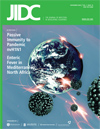Chikungunya: an emerging and spreading arthropod-borne viral disease.
DOI:
https://doi.org/10.3855/jidc.169Keywords:
Chikungunya epidemiology, diagnosis, pathogenesisAbstract
The infection caused by the virus Chikungunya is known since the last 50 years, but since the disease was mainly diffuse in geographical areas located in developing countries, a few research work have been made available until the appearance of an important epidemiological outbreak in 2005 in the island of La Reunion, that is part of metropolitan France even if located in the Southern Eastern part of the Indian Ocean. In 2007, a smaller outbreak of Chikungunya developed in the Northern Eastern part of Italy, where the local transmission has been made possible by the enormous population of Aedes albopictus and the presence of a viremic patient coming from the Indian Ocean area. Nowadays, Chikungunya is spreading in Southeast Asia countries, including Indonesia, Malaysia, Thailand and Singapore. This paper reviews different aspects of the disease caused by Chikungunya virus, including: history, epidemiology, biological and pathogenetic aspects, clinical pictures, diagnosis and treatment.Downloads
Published
2009-11-21
How to Cite
1.
Cavrini F, Gaibani P, Pierro AM, Rossini G, Landini MP, Sambri V (2009) Chikungunya: an emerging and spreading arthropod-borne viral disease. J Infect Dev Ctries 3:744–752. doi: 10.3855/jidc.169
Issue
Section
Reviews
License
Authors who publish with this journal agree to the following terms:
- Authors retain copyright and grant the journal right of first publication with the work simultaneously licensed under a Creative Commons Attribution License that allows others to share the work with an acknowledgement of the work's authorship and initial publication in this journal.
- Authors are able to enter into separate, additional contractual arrangements for the non-exclusive distribution of the journal's published version of the work (e.g., post it to an institutional repository or publish it in a book), with an acknowledgement of its initial publication in this journal.
- Authors are permitted and encouraged to post their work online (e.g., in institutional repositories or on their website) prior to and during the submission process, as it can lead to productive exchanges, as well as earlier and greater citation of published work (See The Effect of Open Access).








